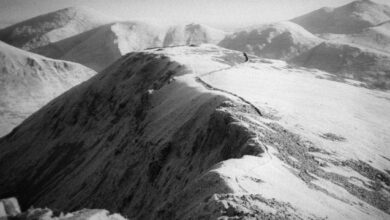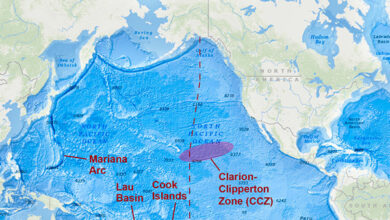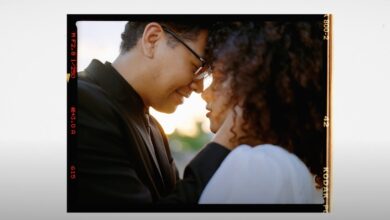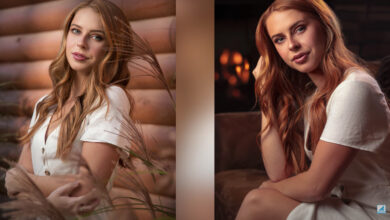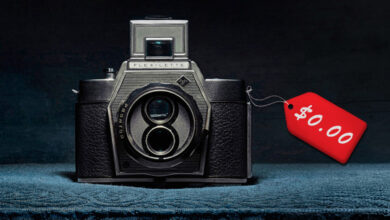Which Nikon Z Midrange Zoom Is Right for You?
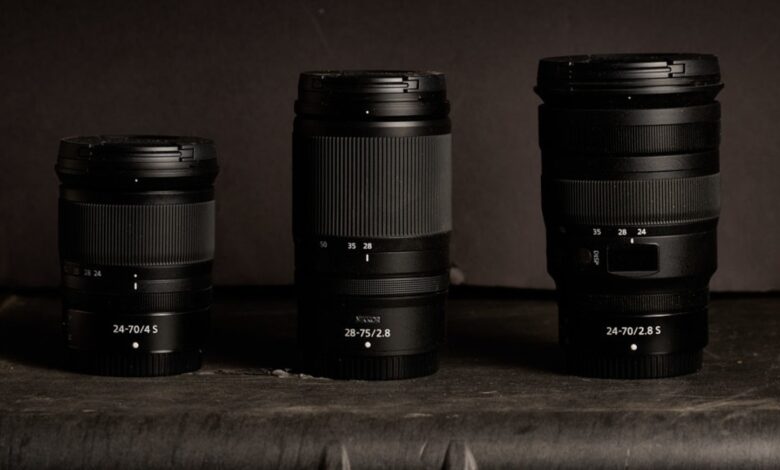
With the release of the Nikon NIKKOR Z 28-75mm f/2.8, I thought it would be a good time to take a look at the current list of options for photographers of all types.
I’ve written before about the 24-70mm f/2.8 range. It sits right in the middle of the traditional “holy trinity” of zoom lenses used by professional photographers the world over. It’s surrounded by the 14-24mm f/2.8 on one side and the 70-200mm f/2.8 on the other. For many, these three lenses will be enough to get them through their entire career. Depending on what type of career you wish to have, you may rely more heavily on one than the other, or your career or preferences might take you in the direction of primes or lenses outside any of the three ranges.
Personally, the 24-70mm f/2.8 is the first lens I buy for any camera system. I am a commercial advertising photographer, director, and cinematographer, and the majority of my work falls into the activewear and lifestyle category. I shoot a lot of athletes and active people. But I’m not a photojournalist shooting from the sidelines. Rather, I am shooting in controlled situations with subjects that are well aware of my presence. So, I can get close to my subjects if I want to.
There are a lot of ways to shoot the work that I do, but I find the 24-70mm f/2.8 to be the most convenient. However, it must be said that although nearly 95% of the images in my portfolio were taken with a 24-70mm f/2.8, I’m not sure it would be accurate to call it my “favorite” lens. There’s nothing particularly exciting about the range. But I find it to be, by far, the most efficient range. And, when I’m working, speed matters. 24-70mm is the one range that I can slap on and feel pretty confident that I’ll be able to make it through an entire shoot without ever needing to change my lens. I have primes as well as the other two holy trinity lenses in my bag. But rarely do they make it out to play when I’m working professionally, aside from occasional shots that simply require a wider frame or greater reach.
So, as I began building my lineup of Nikon Z glass to go with the new mirrorless cameras, it’s no surprise that the first lens I invested in was the Z 24-70mm f/2.8 S. I’ve been shooting with Nikon for a long time. So, I have a bag full of F mount glass that works perfectly well on the Nikon mirrorless bodies via the FTZ II adapter. But, knowing 24-70mm f/2.8 would be the workhorse range, I knew it would be worth the investment.
But now, a few years into the mirrorless age, Nikon offers not one, not two, but three variations of the 24-70mm — four, if you count the 24-120mm as a viable alternative. So, which of these lenses is the best fit for you?
Z 24-70mm f/2.8 S
In my own opinion, this is the best 24-70mm f/2.8 that Nikon has ever made. It is both light and tack sharp. The aperture is plenty fast enough for my needs. And very important to those of us who also do video, it shows very little sign of focus breathing. When I take out my Z 9 to do a client shoot or create for myself in earnest, this is the first lens that will be glued to the front of my camera for the bulk of the day. This may not be a super exciting way to frame it, but the biggest compliment I can give this lens is that it is my default setting. It just can get the job done, regardless of the situation. It solves problems.
Of course, as you might expect, it is also Nikon’s most expensive option in the range. But, for a lens that is never going to come off my camera, it’s well worth the coin.
Z 24-70mm f/4 S
If you bought your Nikon Z camera as part of a kit, there’s a good chance that the 24-70mm f/4 S came with it. While it surrenders a stop of light and a bit of bokeh, this lightweight, compact option is a tremendous value for those on the go. Currently listed at just under $1000 on B&H, it’s easy on the wallet or, easier, at least. And if you buy it as part of a kit, you get an even better deal. The Z 6 II, for example, is currently $1,996.95. But, if you buy it with the 24-70mm f/4 S kit lens, the entire package only costs you $2,596.95. So you are essentially only paying $600 for the lens.
Making the deal even more attractive is that, despite the price differences, I have yet to find a Z lens that isn’t a high performer. I’ve done shoots with each of the lenses mentioned in this article and have yet to need to discard any images from my sessions due to some deficiency in the lens. I’ve thrown away more than one image due to my shortcomings. But technical failure isn’t something I’ve had to work about.
Having had three variations of the Nikon 24-70 zoom range lenses in my possession for the last several months, I’ve done a handful of side-by-side tests. I am not a pixel-peeping kind of guy. If you want scientific lab tests, there is no shortage of articles on the web that provide them. Rather, I am more concerned with practical application and whether or not I would feel comfortable delivering an image shot with a lens to my most demanding clients. If the answer is “yes,” that’s all the technical validation I need. And every Nikon Z lens I’ve tested up to this point has more than fit that bill.

No, mathematically speaking, this is technically not a 24-70mm. But, I imagine those buying it will be using it in much the same way as they would the previous two lenses mentioned. At 28mm on the wide end, it’s not quite as wide a field of view as the others. And at 75mm on the long end, it has just a smidgen more reach. But those differences are fairly negligible in the real world unless you have very specific targets that don’t allow you to move forward or back a few inches.
I don’t mind the 28mm as opposed to the 24mm. I tend to get excited during shoots and move in for super closeups of my subjects without realizing I’m shooting a closeup at 24mm. Not that one can’t do this, but I do find 28mm to be less distorting than 24mm, so, in a way, this lens can protect me from… myself.
This lens also comes in at under $1,000. $996.95 to be specific. So, it is the same price as the 24-70mm f/4 and the same aperture as the more expensive 24-70mm f/2.8.
I got a chance to shoot with this lens recently in both casual and professional situations. Like the other Nikon Z lenses, the performance didn’t disappoint. I was expecting to see a major fall-off in quality, given the price difference versus my default lens, but the 28-75mm held its own. The main difference I noticed with this option was that focused breathing, though still manageable, did seem more pronounced in this lens versus the 24-70mm f/2.8 S model. If you are a video shooter, this is something you’ll want to test for yourself. Likewise, at the wide end of the lens, there was some vignetting. You can fix this easily in post, but it is a consideration to take into account.
I’ll get to which lens is best, and for what kind of photographers, in a moment. But, for the majority of photographic applications, this lens would be more than sufficient to get the job done.
Z 24-120 f/4 S
Add just one hundred dollars onto the cost of the previous two lenses listed and you can get between 45 to 50mm more reach. Again, I am aware that this is not a 24-70mm lens. And, of all the lenses in this article, this is the one lens that I have not yet personally had my hands on. But I wanted to include it here because, in many ways, it’s the most intriguing.
I had the old Nikon 24-120mm f/4G ED VR lens for my F mount DSLRs. For years, it was the only lens I needed to shoot. I was both wide enough and long enough. It was a great weight for all-day shoots. In many ways, it was a lens that went hand in hand with my portfolio for years as it was the one workhorse lens that came with me on every job. Eventually, I invested in the more expensive Nikon 24-70mm f/2.8E ED VR lens. I wanted the extra stop and added sharpness. The 24-70mm delivered both. However, both those things came at the expense of added weight and ergonomics that, despite how much I love the results, never quite felt perfect for my sense of balance. I always missed the ease of shooting with the 24-120mm and, despite the clear technical advantages of the 24-70mm, some part of me always wished I could still get the same performance out of the 24-120mm and make my life easier.

Nikon has fixed this in several ways with its Z mount lenses. As I said earlier, the Z 24-70mm f/2.8 S is, in my opinion, the best lens they’ve ever made. Partly, this is due to tech specs like focusing speed, sharpness, and so forth. But, if you know nothing else about me, you know how much I value practicality over lab tests. And, somehow, Nikon has been able to provide all of those benefits in a lens that is significantly lighter and better balanced than its F mount predecessors.
I don’t see another lens overtaking the 24-70mm f/2.8 S as my go-to lens any time soon, but I am looking forward to getting the 24-120mm f/4 S in hand. Considering how many lens improvements Nikon has made so far, I’m interested to see how they’ve improved the newer version of the 24-120mm as well in terms of sharpness and responsiveness. If the other Z lenses are anything to go by, I have confidence that it should be pretty darn good.
So Which Should You Buy
As the minutiae of my earlier lens choice descriptions have shown, you’ll probably realize that finding the right lens for you is a highly personal decision. Again, you can certainly look at lens tests to figure out which of these pieces of glass perform the best when photographing charts. But, if you want to know which will be the perfect fit for your special brand of creativity, you’ll need to try them out on your own.
Having had three of them, the Z 24-70mm f/2.8 S, the Z 24-70 f/4 S, and the Z 28-75 f/2.8, in my possession for the last few months, I have noticed a few strengths and weaknesses of each which might guide you in your decision.
If you are a professional photographer working with high-end clients who need the best of the best, and things like absolute sharpness, maximum speed, and a lack of focus breathing are essential to you performing your job, then I still hold that the Z 24-70mm f/2.8 S is worth the investment. Yes, it’s the most expensive lens on this list, but I also feel as though it is the most expensive for a reason. There is virtually no job that can’t be performed by this lens — at least no job that I would likely find myself doing. Again, your needs may vary in terms of required focal length and aperture. But, within this range, I don’t think you can do much better than the Z 24-70mm f/2.8 S.
With that said, money is money. And, if you are not someone who is shooting images tethered to a large computer monitor surrounded by a small squadron of hangry executives with eagle eyes for detail and limited patience, then the 28-75mm f/2.8 could be a very viable option. Let’s say, for example, you run a small local portrait business where margins are small and every dollar of investment is critical. Saving over 50% off the Z 24-70mm f/2.8 S version could be a big boon to your bottom line. Likewise, if you are shooting portraits for the love of photography, rather than to make your living, the 28-75mm is a more than apt performer. It still puts you in the heavily used focal range, with the benefit of an f/2.8 aperture, while being acquired at a fraction of the costs.
So, why would you opt for the 24-70 f/4 S? The kit lens still provides a few benefits that the others don’t. Like the 28-75mm, it is the least expensive option in the range. It’s even roughly 60% of the costs of the 28-75mm if you are buying it as part of a kit. As this is the kit lens, and likely one that many choose to replace, you also stand a really good chance of picking one of these up on the used market. So, if you are just starting and want to get into the system without a high investment, this is an excellent choice.
Yes, you sacrifice a stop and a little bit of bokeh. But, I think we can all agree that shooting wide open can be a bit overrated. Bokeh is great, but it’s not the be-all and end-all in making a strong image. Likewise, unless you’re shooting in super-dark scenarios, you may not find yourself needing anything beyond f/4 to get a decent exposure. With the improved high-ISO performance of modern-day cameras, f/4 isn’t the detriment that it used to be. So, saving money on the f/4 version of the lens can often be just as effective for less money.
One thing that the f/4 version has over its competitors is its compact size. When in its locked position, this lens shrinks down to be able to fit into even the smallest of camera bags. If you travel a lot, this could be a key consideration in terms of pure logistics. Although, one should keep in mind that this lens needs to be extended before use. So, once you unlock it, it becomes roughly the same size as the other two lenses. So, your size savings aren’t quite so prominent when in use.
You may also either enjoy or detest the locking mechanism. You’ll love it when you go to pack it in your bag. But you may hate it when you want to grab your camera and shoot right away only to realize you haven’t yet unlocked the lens. It’s not the end of the world, but these extra few seconds can be enough to make you miss a shot. So, you’ll have to decide if you prefer speed or portability.
Since I haven’t had it in hand, I can’t fully review the 24-120 f/4 S yet. But, based on my experience with the previous F mount version, the advantage to that one seems clear. 24-70mm is a great range for much of my work. But that extra reach to 120mm comes in handy more than you might think, especially if you are considering it as an everyday lens or a travel lens. You can simply get more shots with more reach. There’s no other way to put it. I’d have to test it myself before I can say how it performs in the field. But, I can imagine the possibilities.
So which 24-70mm do you prefer? What do you find most effective for the type of work that you do? Is the 24-70mm f/2.8 S model worth the extra money? Or do you find the 28-75mm to be a great fit for your needs? Let me know what you think.
